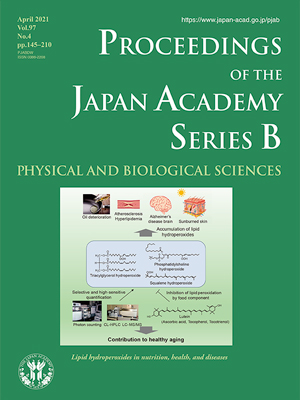About the Cover
Vol. 97 No. 4 (2021)
Lipid peroxidation has long been of great interest among researchers because of its association with food deterioration and with loss of biological function. The research by Miyazawa et al. on lipid peroxidation in food degradation, oil and fat nutrition, and age-related diseases has gained significant international attention for the improvement of social health and longevity (see this issue, pp. 161-196).
Lipid peroxidation reactions produce lipid hydroperoxides as an initial oxidation product, which further decompose and produce later products, including alcohols, ketones, and aldehydes. In order to advance the study of lipid oxidation, it was essential to establish a methodology for the sensitive quantification of lipid hydroperoxides such as triacylglycerol hydroperoxide (TGOOH), phospholipid hydroperoxide (PLOOH), squalene hydroperoxide (SQOOH), and so on. The precise structural analysis of hydroperoxides helped Miyazawa et al. to understand the reaction mechanism of lipid peroxidation and to plan measures to prevent lipid peroxidation in food and in our bodies. They first assembled the world's most sensitive single photoelectron counting apparatus to perform photon counting from rancid fats, oils, and living tissues. They observed that the photon emission intensity of Drosophila larvae was inversely correlated with their lifespan. From electron spin resonance and emission spectral analysis, they found that this photon emission involves the formation of free radicals and reactive oxygen species. Having applied this photoemission reaction to the detection unit, they developed a chemiluminescence-high performance liquid chromatography (CL-HPLC) system to quantify lipid hydroperoxides specifically at the hydroperoxide group. At the same time, they established a method for the preparation of authentic lipid hydroperoxides necessary for identification and discrimination of the position and stereoisomerization of hydroperoxide groups among enzymatic oxidation, autoxidation, and singlet oxygen oxidation. Furthermore, with the combined use of CL-HPLC and liquid chromatography–tandem mass spectrometry (LC-MS/MS), they confirmed, for the first time that PLOOH in hyperlipidemia was involved in phenomena in the human body such as atherosclerosis, diabetes exacerbation, the appearance of aged red blood cells in dementia, the peroxidation of hepatocyte membrane lipids by hepatitis C virus, as well as the occurrence of SQOOH in human sebum following sunlight exposure. It was proven that food ingredients and components prevented the hydroperoxide formation through an antioxidant function in our bodies. As a result of the studies done by Miyazawa et al., new phenomena in lipid peroxidation in food and in the human body were discovered, which clearly showed the contribution of food to our bodies for health and longevity.
Takeshi Yasumoto
Member of the Japan Academy




